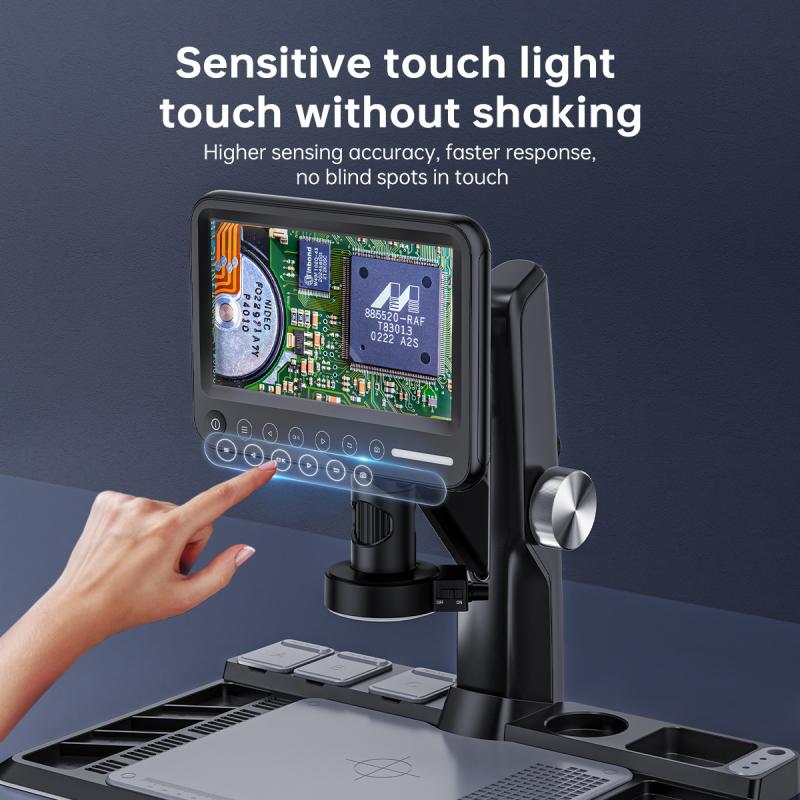What Can You See In An Electron Microscope ?
In an electron microscope, you can see extremely small objects and details that are not visible to the naked eye or even with a light microscope. This includes the fine structure of cells, tissues, and microorganisms, as well as the arrangement of atoms in solid materials. The high magnification and resolution of electron microscopes allow for the visualization of intricate features and the study of nanoscale phenomena.
1、 Cellular Structures and Organelles
In an electron microscope, one can observe cellular structures and organelles with remarkable detail and precision. This powerful tool allows scientists to delve into the intricate world of cells and explore their inner workings.
One of the most prominent features that can be seen in an electron microscope is the cell membrane. This thin, flexible barrier surrounds the cell and controls the movement of substances in and out of the cell. The electron microscope provides a high-resolution view of the cell membrane, revealing its composition and structure.
Inside the cell, various organelles can be observed. The nucleus, often referred to as the control center of the cell, is easily visible in an electron microscope. It contains the cell's genetic material, DNA, and is responsible for regulating cell activities.
Other organelles, such as mitochondria, endoplasmic reticulum, Golgi apparatus, and lysosomes, can also be visualized in great detail. These organelles play crucial roles in cellular processes such as energy production, protein synthesis, and waste disposal.
Furthermore, electron microscopy allows scientists to study the cytoskeleton, a network of protein filaments that provides structural support to the cell and facilitates cell movement. This intricate network of microtubules, microfilaments, and intermediate filaments can be observed and analyzed in an electron microscope, providing insights into cell shape, division, and motility.
It is important to note that advancements in electron microscopy techniques have enabled scientists to explore cellular structures and organelles at nanoscale resolutions. Cryo-electron microscopy, for example, has revolutionized the field by allowing the visualization of biomolecules and cellular structures in their native state, providing unprecedented insights into their functions and interactions.
In conclusion, an electron microscope allows scientists to see cellular structures and organelles in incredible detail. From the cell membrane to the nucleus, and from mitochondria to the cytoskeleton, this powerful tool provides a window into the intricate world of cells, enabling researchers to unravel the mysteries of life at the microscopic level.

2、 Microorganisms and Viruses
In an electron microscope, one can observe a wide range of microorganisms and viruses. These powerful microscopes use a beam of electrons instead of light to magnify the specimen, allowing for much higher resolution and greater detail to be observed.
Microorganisms, such as bacteria, fungi, and protozoa, can be visualized in an electron microscope. The high magnification and resolution of electron microscopes enable scientists to study the intricate structures of these microorganisms. For example, the electron microscope can reveal the cell wall, cell membrane, cytoplasm, and organelles within a bacterial cell. This level of detail is crucial for understanding the physiology and behavior of microorganisms.
Similarly, electron microscopes are instrumental in studying viruses. Viruses are much smaller than bacteria and cannot be seen with a light microscope. However, electron microscopes can capture detailed images of viruses, revealing their unique shapes, sizes, and structures. This information is vital for identifying and classifying different types of viruses.
Moreover, electron microscopes have advanced in recent years, allowing for even more detailed observations. For instance, cryo-electron microscopy (cryo-EM) has revolutionized the field by enabling the visualization of biological samples in their native, hydrated state. This technique has provided unprecedented insights into the structure and function of viruses and other biological macromolecules.
In summary, an electron microscope allows scientists to see microorganisms and viruses in great detail. From the complex structures of bacteria to the intricate shapes of viruses, these powerful microscopes have significantly contributed to our understanding of the microscopic world. With advancements in technology, electron microscopy continues to push the boundaries of scientific discovery.

3、 Nanomaterials and Nanoparticles
In an electron microscope, one can observe nanomaterials and nanoparticles with exceptional detail and resolution. These powerful microscopes use a beam of electrons instead of light to magnify the sample, allowing for a much higher level of magnification and clarity.
When examining nanomaterials, electron microscopes can reveal their unique structures and properties at the nanoscale. This includes the arrangement of atoms, crystal structures, and surface morphology. For example, in carbon nanotubes, electron microscopy can provide insights into their diameter, length, and chirality, which are crucial for understanding their mechanical, electrical, and thermal properties.
Similarly, nanoparticles can be thoroughly examined using electron microscopy. The size, shape, and surface characteristics of nanoparticles can be precisely determined, which is vital for understanding their behavior and applications. For instance, in the field of medicine, electron microscopy can help analyze the size and shape of drug-loaded nanoparticles, enabling researchers to optimize their delivery and efficacy.
Moreover, electron microscopy techniques such as scanning electron microscopy (SEM) and transmission electron microscopy (TEM) can provide additional information about nanomaterials and nanoparticles. SEM allows for the visualization of the three-dimensional surface morphology of the sample, while TEM provides insights into the internal structure and composition.
In recent years, advancements in electron microscopy have further expanded its capabilities. For instance, aberration-corrected electron microscopy has significantly improved the resolution, allowing for the visualization of individual atoms in nanomaterials and nanoparticles. This breakthrough has revolutionized the field of nanoscience, enabling researchers to study and manipulate materials at the atomic level.
In conclusion, electron microscopy is a powerful tool for studying nanomaterials and nanoparticles. It provides detailed information about their structure, size, shape, and surface characteristics, which are crucial for understanding their properties and applications. With ongoing advancements, electron microscopy continues to push the boundaries of nanoscience and contribute to the development of innovative nanotechnologies.

4、 Surface Topography and Morphology
In an electron microscope, one can observe the surface topography and morphology of various materials and objects at an incredibly high resolution. This powerful tool allows scientists to delve into the nanoscale world and explore the intricate details of the surface features.
The electron microscope uses a beam of electrons instead of light to create an image. This enables it to achieve much higher magnification and resolution compared to traditional light microscopes. With this technology, researchers can examine the surface of a wide range of samples, including metals, ceramics, polymers, biological specimens, and even individual atoms.
When looking at the surface topography, an electron microscope can reveal the fine details of the sample's surface, such as roughness, texture, and the presence of cracks or defects. This information is crucial in fields like materials science, where understanding the surface properties is essential for designing and improving materials with specific functionalities.
Moreover, the electron microscope can provide insights into the morphology of the sample, which refers to its shape, size, and arrangement of its constituent parts. For example, in biology, electron microscopy has been instrumental in studying the structure of cells, tissues, and even viruses. It allows scientists to visualize the intricate details of cellular organelles, the arrangement of proteins, and the interactions between different components.
In recent years, advancements in electron microscopy techniques have further expanded its capabilities. For instance, scanning electron microscopy (SEM) can generate three-dimensional images of the sample's surface, providing a more comprehensive understanding of its structure. Additionally, transmission electron microscopy (TEM) allows scientists to observe the internal structure of thin samples, such as individual nanoparticles or the atomic arrangement in crystalline materials.
In conclusion, an electron microscope offers a remarkable view of the surface topography and morphology of various materials and objects. Its high resolution and magnification capabilities enable scientists to explore the nanoscale world and gain valuable insights into the structure and properties of different samples. With ongoing advancements, electron microscopy continues to push the boundaries of scientific understanding and contributes to numerous fields, from materials science to biology.






























There are no comments for this blog.